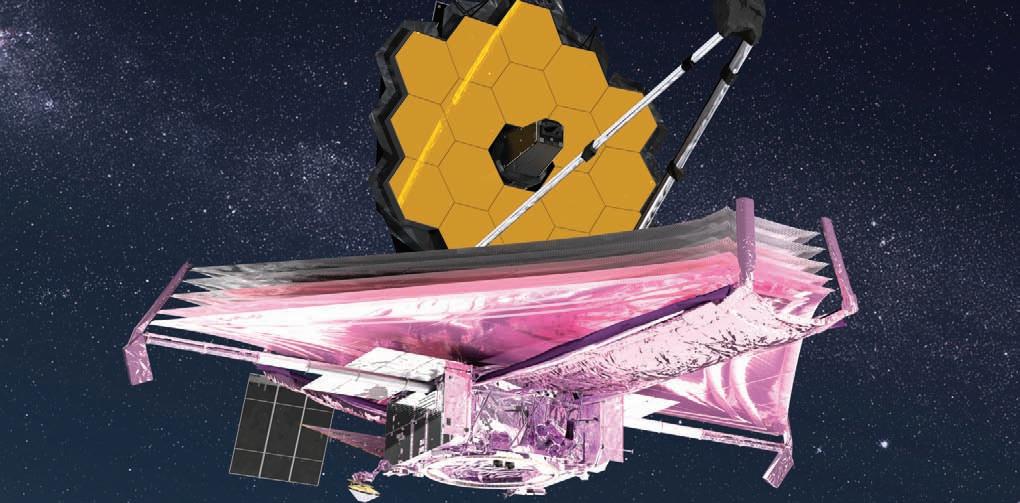
14 minute read
James Webb Space Telescope exceeds expectations
Artist rendering of the James Webb Space Telescope. Photo courtesy NASA GSFC/CIL/Adriana Manrique Gutierrez
The stunning views of the universe emanating from the James Webb Space Telescope have already exceeded the expectations of every astronomer on Earth and this is just the beginning. Indeed, the buzz surrounding the imagery is so jubilant that it’s easy to overlook the extraordinary effort required to bring the world’s premier space science observatory to life. Scott Willoughby, Vice President of the Webb program at Northrop Grumman, and Charlie Atkinson who served as Chief Engineer on the telescope spent more than a decade making sure the job was done right.
Crispin Littlehales Executive Editor, Satellite Evolution Group
Who of us has not looked up at the stars and wondered, “Where do we come from, and are we alone?” Discovering the answers to those cosmic questions is what compelled NASA to embark upon the creation of the James Webb Space Telescope.
The notion of making an infrared-optimized telescope that could observe what the Hubble Space Telescope (HST) was not designed to detect surfaced in the late 1980s. But it wasn’t until Dr. Alan Dressler and a committee of top-notch astronomers released the HST and Beyond report in 1995 that NASA committed to delivering the nextgeneration space telescope.
In an interview last February. Dressler, who is staff scientist Emeritus at Carnegie Observatories, told David Zierler, oral historian for the American Institute of Physics, “NASA grabbed it and ran and I believe that part of the reason HST & Beyond caught on was that it was something new for these reports to see a big idea—origins, holding things together. Not just hardware, and not just the science of doing this and that, but something bigger. Here were astronomers showing the passion they had for their work, something very human that appealed to the general public.”
ENTER: THE DREAM TEAM
It is one thing to conceive of a telescope capable of seeing more than 13 billion years into the past and quite another thing to build one. NASA knew from the start that the nextgeneration space telescope would require complex and sophisticated state-of-the-art engineering and technology that had yet to be invented. That meant finding industry partners who were both capable of working miracles and committed to the long haul.
Only two teams were competing; one was led by Lockheed Martin and the other was assembled by Northrop Grumman and included Ball Aerospace; L3Harris, which, at the time was part of Kodak, and Orbital ATK, which was later acquired by Northrop Grumman (see sidebar, “Who did what”).
Charlie Atkinson recalls, “In the late 1990s when we were first trying to conceive of what Webb was going to look like and how it was going to achieve the science objectives, we had a number of different architectures that we looked at. From the perspective of complexity, cost, and how able it was to achieve the mission science, it was very clear that the right choice was the architecture we see today. We also felt that the configuration of the optics and how to manufacture them was much, much more affordable if they were smaller segments. We made numerous decisions and evaluations before the selection, but the interesting thing is that the architecture didn’t change much after that.
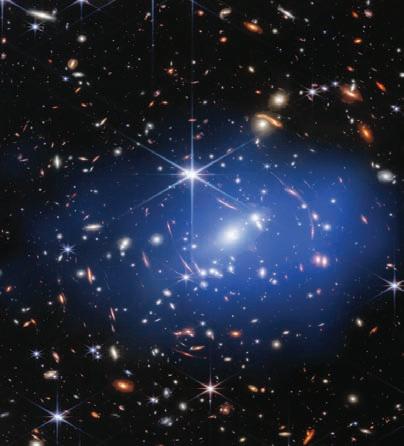
The James Webb Space Telescope shows how the galaxy cluster SMACS 0723, located about 4.2 billion light-years away, contains hundreds of individual galaxies.
Photo courtesy Northrop Grumman
“We’d put a lot of engineering and analysis behind it to have confidence that it was going to be successful,” Atkinson explains. “We also made sure that the government saw how we were doing our analyses and we reviewed our results with them, so they had confidence that what we were telling them was, indeed, true.”
A COMPLEX STRUCTURE WITH NO ROOM FOR ERROR
Webb is not only huge and complex, but it also needed to be folded up inside the cone of a rocket, survive the launch, unfold perfectly during deployment, and function flawlessly in orbit 1.5 million kilometers from Earth. “There are 344 single-point failures in the James Webb Space Telescope which is three or four times the amount on the Mars Perseverance rover,” notes Scott Willoughby. “178 of those were just bolts that were used to hold it together for launch. Then there were lots of hinges and if one of those didn’t work, the sunshield or mirror couldn’t unfold.
“Our job was to make that number as small as humanly possible. I remember in 2011 when sunshield manager Jim Flynn was so excited that we finally went from 109 to 107 fasteners on the sunshield,” says Willoughby. “It was two fewer things that could go wrong, but that’s how hard this job was.”
According to the literature, there were ten technologies that needed to be invented for Webb to work (See sidebar: Ten inventions), but if you drill down, you’ll discover there’s more than meets the eye. Atkinson explains, “For example, with the backplane or structure, we took what was the state-of-the-art at the time for implementing a spaceborne optical telescope and we needed to make it work at 40 degrees above absolute zero and we needed to make it three orders of magnitude more stable than has ever been demonstrated before. Then we had to prove that our approach was going to succeed. Well, we didn’t have a way to do that since no one had ever tested a structure by itself to that precision, so NASA invented a technology called electron speckle pattern interferometry to go measure it.”
The same is true for the telescope’s mirrors. “Number one, they are ten times lighter than the mirror on the Hubble Space Telescope, and number two, it’s a brandnew type of beryllium processing that was invented to ensure it was stable enough,” Atkinson continues. “The actuators behind it must operate at cryogenic temperatures and they need to make adjustments smaller than 10 nanometers, which was also a new technology. Then, too, we had to create a novel way to measure it.”
Willoughby echoes the sentiment, “What doesn’t get the credit is the development of systems that never existed before. Nobody gives attention to creating a measurement technology or a way to prove that an invention works. Those efforts aren’t seen as being exciting, but for us, it was critically important for something that was going to perform a million miles away from Earth and be unserviceable.”
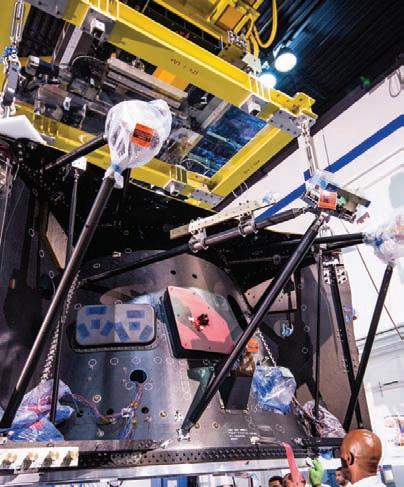
Photo courtesy Northrop Grumman
TESTING ON EARTH WHAT WILL HAPPEN IN SPACE
“We had to develop how we modeled the system because the deployed telescope operating in space never occurred here on Earth,” notes Willoughby. “We could not deploy the sunshield and the optics together and we certainly couldn’t put them in a thermal vacuum chamber and simulate the hot and cold environment. That was physically impossible.”
Operating at cryogenic temperatures definitely added complexity and an engineering challenge across the entire observatory. “It meant that every single material that was used on the telescope and the instruments, as well as a good portion of the sunshield, had to be characterized at those temperatures,” explains Atkinson. “When you get down into the 40 Kelvin and below range, you need liquid helium.
“The facility down at Marshall Space Flight Center was augmented with a large helium shroud and we used it extensively for doing backplane characterization and the testing of the mirrors. Ball Aerospace put together a chamber in their facility and here at Northrop we had some test facilities that we modified for use at Webb’s extremely cold temperatures.”
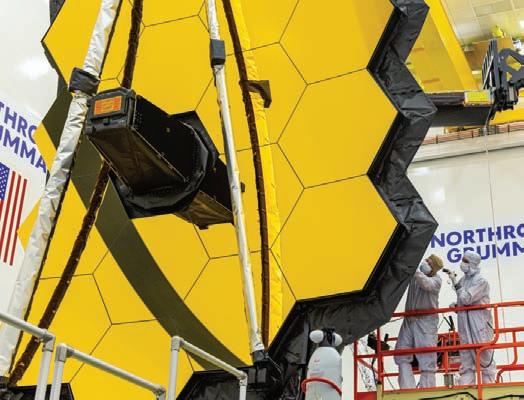
For the last time on Earth, the James Webb Space Telescope opened its primary mirror in May 2021.
Photo courtesy Northrop Grumman
The end-to-end cryo vacuum optical test for Webb’s Optical Telescope Element (OTE) and Integrated Science Instrument Module (ISIM) was performed at the NASA Johnson Space Center which had been used to conduct thermal-vacuum testing for all manned spacecraft for the Apollo missions. Chamber A was retrofitted with thermal shrouds, helium refrigeration, liquid nitrogen system, high vacuum clean airflow system, and utilities.
“The chamber could be cooled to somewhere around 10 degrees Kelvin. We then had to attach the telescope and dynamically isolate the optic to measure micron or sub-micron wavelengths. Plus, the chamber was shaking because there were pumps pumping the air out to keep the vacuum and pumping in helium to keep it cold,” recalls Willoughby. “These dynamic isolators were hanging from six points on the top of this seven-story chamber with the telescope dangling below and we’re doing nanometer precision optical measurements. It was magnificent.”
“We would build, then test,” says Atkinson. “You build a mechanism, you test that mechanism and make sure it works in cryogenic temperatures and through all of its performance—the torque versus angle and the amount of current that it draws, then you build that up into a structure so that now you have a deployable structure, and you test it at that level. Then you build it into the observatory and test it at that level so you’re creating a test record on all these components and all these systems and how they behave over time.”
One of the other things that Northop Grumman introduced as part of its proposal was a Pathfinder. “We built up a telescope structure before the flight one was created,” Atkinson explains. “Then we practiced putting the mirrors on it. Then we practiced the Johnson Space Center test on it. By doing that, we could test out all the integration processes and get all those test bugs out of the way before we had to do it on the flight.”
ESTABLISHING TRUST AND WORKING AS A TEAM
“Our suppliers were our teammates and we treated them as such,” Willoughby states. Indeed, Atkinson split his time between Ball Aerospace in Boulder, Colorado; L3 Harris in Rochester, New York; and Orbital ATK in Magna, Utah. “It was really important to be there in person because looking someone in the eye and having an honest conversation is crucial to building a trusting relationship, “says Atkinson.
“There was such synergy going into the proposal: what Ball was capable of in terms of their history with cryogenic optics and their work on other parts of the telescope; what L3 Harris had done building large optical systems like the Chandra where they integrated this enormous 10-meterlong telescope that included very unusual cylindrical optics; and Orbital ATK who developed the backplane composite structure. Bringing all those strengths together and making sure we worked as a team was very important.”
Needless to say, the team worked closely with NASA as well. Northrop Grumman set up an office right down the street from the NASA Goddard Space Flight Center and Atkinson moved from Redondo Beach, California to Maryland. “I went to meetings on the Goddard campus practically every day to make sure that we were communicating effectively and frequently. We invited NASA to join us when we met with the other team members to ensure there was transparency up and down the line,” he explains.
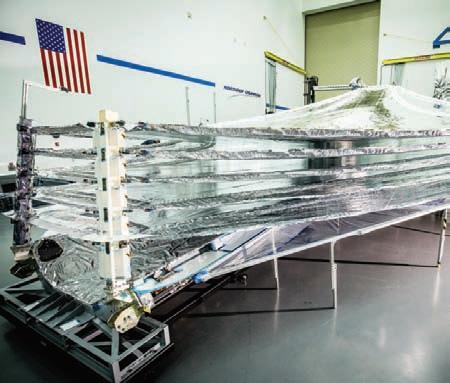
Telescope sunshield.
Photo courtesy Northrop Grumman/ Alex Evers
Representatives from all those entities were needed to integrate the optics into the telescope structure at Goddard. “We were all there during those operations and also when we did the testing at Johnson,” notes Atkinson. “It was the same when we were up at Space Park in California when we all supported the integration of the telescope to the sunshield and the spacecraft. We started as separate entities in physically different locations, but then all of us followed the observatory around as it was being put together.”
BOOSTING MORALE IN THE FACE OF SETBACKS
Exciting though it was, creating Webb was stressful, and it took years to get to the finish line. One might well wonder how Northrop Grumman managed to keep the team inspired and on track. “It’s sprints inside a marathon,” says Willoughby. “We had to admit that the mission would be hard, and that the expectation was singular: we will be successful in orbit. We acknowledged there were going to be stumbles on the ground.
“When something went wrong, we would ask ourselves, what did we learn from this? What do we do next? Let’s not make the same mistake twice. So, we gave ourselves a different vantage point. In staff meetings, I encouraged everybody to tell us if they were worried and reminded them that they had a right to say, ‘let’s read the procedure again’,” he adds.
“Every time we had a success, we celebrated it. We did fun things like going to a bowling alley or a local place in the park. We had a monthly recognition where we would read people’s names out loud and present them with a challenge coin and applaud.”
That went on every four weeks for more than a decade.
THE FINAL FRONTIER
What was it like when Webb finally left the Earth and headed to its ultimate destination? Atkinson recalls, “It was one long, slow breath out from launch all the way through commissioning. We got past the launch, and that was great. Then we saw the solar array deploying and that was fantastic. All the way, 14 days of deployment, that was huge. Then we saw from the telemetry that everything was performing as expected. The temperatures on the telescope started to drop and we knew the sunshield was doing its job. Once we got the telescope aligned, there was that first image, and we knew we had a science mission. Finally, we commissioned all the instruments. Oh my, it was just incredible.”
TEN INVENTIONS NEEDED TO CREATE THE JWST
• Mid-infrared detectors – arrays are lower noise, larger format, and longer lasting than their predecessors
• Sunshield materials – tennis court-sized sunshield is made of five thin layers of Kapton E with aluminum and doped-silicon coatings to reflect the sun’s heat back into space
• Microshutters – tiny windows with shutters that measure 100 by 200 microns
• Wavefront sensing and control – senses and corrects any errors in the telescope’s optics
• Scaled telescope testbed – for the development and testing of wavefront sensing and control
• Lightweight cryogenic mirrors – the primary mirror is 6.5 meters (larger than any other mirror launched in space)
• Cryogenic detector readout application-specific integrated circuit – functions at super-cold operating temperatures
• Cryogenic heat switches – used to cut off a thermal link for operational efficiency
• Cryocooler for the mid-infrared instrument – keeps instruments detectors at a temperature less than 7 kelvin
• Large precision cryogenic structure – backplane engineered to carry more than 2400 kg of hardware while remaining steady down to 32 nanometers
Source: NASA and ESA
NORTHROP GRUMMAN SUBCONTRACTORS: WHO DID WHAT
Ball Aerospace
• Led the development, design, and manufacture of JWST’s entire optics system, including the primary, secondary, tertiary, and fine-steering mirrors.
• Using Wavefront Sensing and Control, Ball’s advanced software calculates the optimum position of each of 18 beryllium mirror segments working as one
• Built cryogenic actuators to accurately align the telescope and enable the telescope’s high-quality, sharp images
• Supported integration and test on these systems
L3Harris
• Integrated components made by various partners to form the Optical Telescope Element
• Combined the components of the Integrated Science Instrument Module
• Administered about 100 days of testing in a cryogenic vacuum chamber at Johnson Space Center
Orbital ATK (now part of Northrop Grumman)
• Delivered the primary mirror backplane support structure which holds the telescope’s primary mirrors motionless while the JWST is in orbit
• Designed and manufactured fuel and oxidizer tanks for JWST
• Performed qualification testing and shipped the propellant tanks to Northrop Grumman for final integration
Source: Ball Aerospace, L3Harris, Orbital ATK







